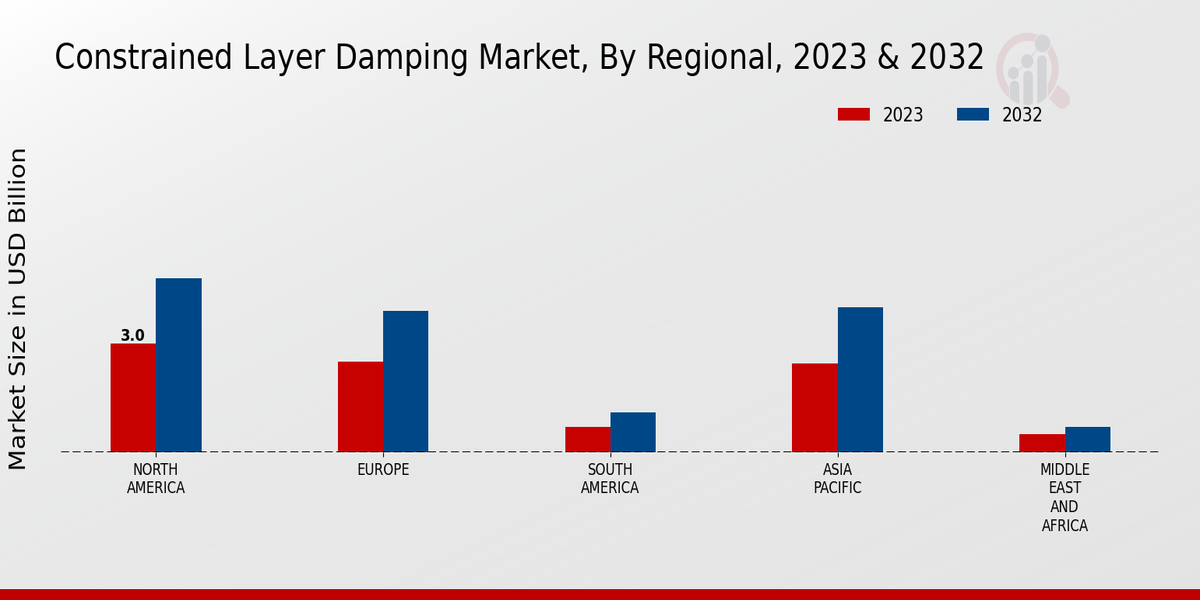Growth of the Automotive Sector
The growth of the automotive sector significantly impacts the Global Constrained Layer Damping Market Industry. As vehicle manufacturers strive to enhance passenger comfort and reduce noise levels, the integration of constrained layer damping materials becomes essential. The automotive industry is witnessing a shift towards electric vehicles, which often require advanced sound insulation solutions to counteract the inherent quietness of electric drivetrains. This trend is expected to propel the market forward, with the automotive sector being a key contributor to the projected market value of 10.1 USD Billion in 2024. The ongoing evolution of vehicle design further supports the demand for innovative damping solutions.
Increasing Awareness of Vibration Control
Increasing awareness of vibration control among industries contributes to the growth of the Global Constrained Layer Damping Market Industry. Industries such as manufacturing, aerospace, and construction recognize the detrimental effects of vibrations on equipment performance and structural integrity. As a result, there is a growing emphasis on implementing effective vibration control measures, including constrained layer damping systems. This heightened awareness is leading to increased investments in damping technologies, as companies seek to enhance operational efficiency and reduce maintenance costs. The market is poised for growth as organizations prioritize vibration control in their operational strategies.
Rising Demand for Noise Control Solutions
The Global Constrained Layer Damping Market Industry experiences a notable increase in demand for noise control solutions across various sectors, including automotive, aerospace, and construction. As urbanization accelerates, the need for effective sound dampening technologies becomes more pronounced. For instance, the automotive sector is increasingly adopting constrained layer damping materials to enhance passenger comfort by reducing road noise. This trend is projected to contribute to the market's growth, with an estimated value of 10.1 USD Billion in 2024. The emphasis on creating quieter environments aligns with global sustainability goals, further driving the adoption of these technologies.
Regulatory Support for Environmental Standards
Regulatory support for environmental standards plays a crucial role in shaping the Global Constrained Layer Damping Market Industry. Governments worldwide are implementing stringent regulations aimed at reducing noise pollution and enhancing energy efficiency in various industries. For instance, the European Union has established directives that mandate noise reduction measures in urban planning and construction projects. This regulatory landscape encourages the adoption of constrained layer damping technologies, as they provide effective solutions for compliance. Consequently, manufacturers are increasingly investing in these technologies to meet regulatory requirements, thereby driving market growth.
Technological Advancements in Material Science
Technological advancements in material science significantly influence the Global Constrained Layer Damping Market Industry. Innovations in polymer composites and viscoelastic materials enhance the performance of constrained layer damping systems, making them more effective in vibration and noise reduction. For example, the development of lightweight materials that maintain high damping efficiency is particularly relevant in the aerospace sector, where weight reduction is critical. These advancements not only improve product performance but also expand the application scope of constrained layer damping solutions. As a result, the market is expected to grow at a CAGR of 5.09% from 2025 to 2035, reaching an estimated value of 17.4 USD Billion by 2035.















Leave a Comment